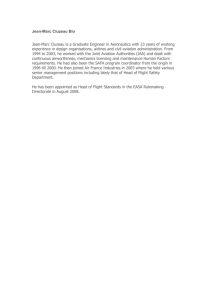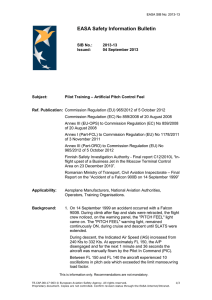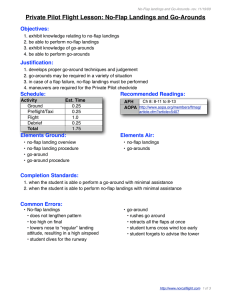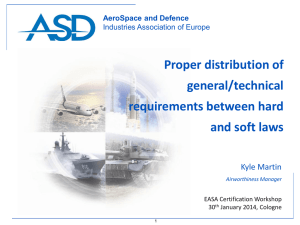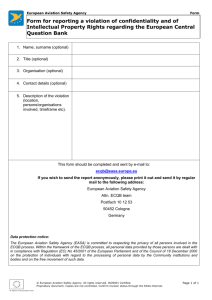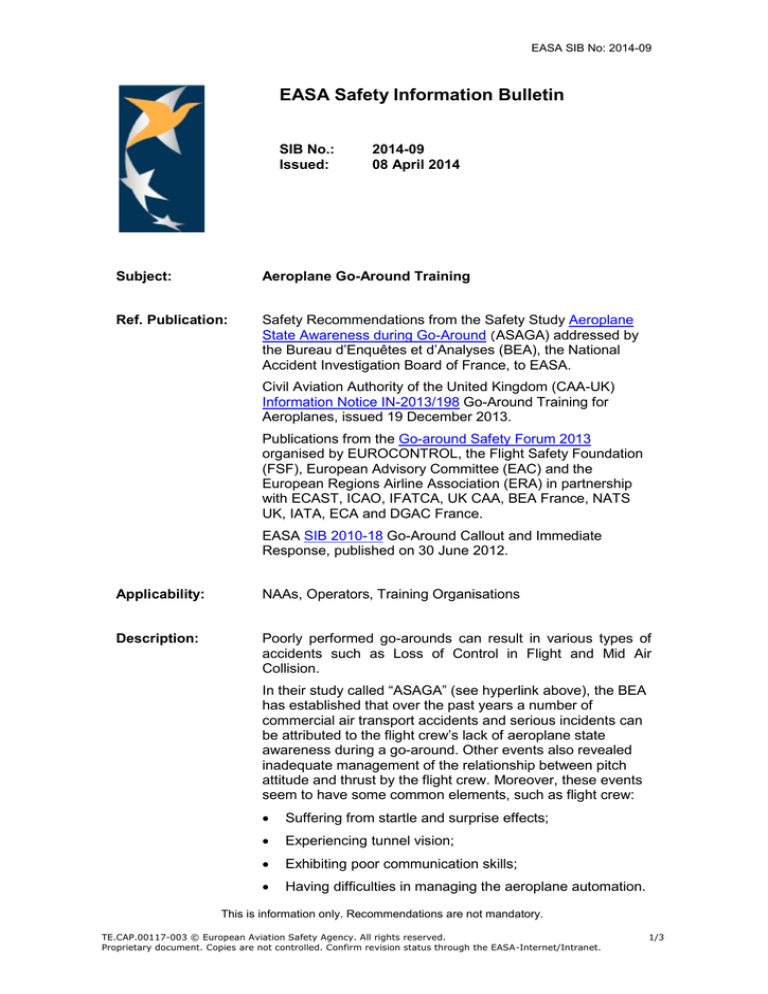
EASA SIB No: 2014-09
EASA Safety Information Bulletin
SIB No.:
Issued:
2014-09
08 April 2014
Subject:
Aeroplane Go-Around Training
Ref. Publication:
Safety Recommendations from the Safety Study Aeroplane
State Awareness during Go-Around (ASAGA) addressed by
the Bureau d’Enquêtes et d’Analyses (BEA), the National
Accident Investigation Board of France, to EASA.
Civil Aviation Authority of the United Kingdom (CAA-UK)
Information Notice IN-2013/198 Go-Around Training for
Aeroplanes, issued 19 December 2013.
Publications from the Go-around Safety Forum 2013
organised by EUROCONTROL, the Flight Safety Foundation
(FSF), European Advisory Committee (EAC) and the
European Regions Airline Association (ERA) in partnership
with ECAST, ICAO, IFATCA, UK CAA, BEA France, NATS
UK, IATA, ECA and DGAC France.
EASA SIB 2010-18 Go-Around Callout and Immediate
Response, published on 30 June 2012.
Applicability:
NAAs, Operators, Training Organisations
Description:
Poorly performed go-arounds can result in various types of
accidents such as Loss of Control in Flight and Mid Air
Collision.
In their study called “ASAGA” (see hyperlink above), the BEA
has established that over the past years a number of
commercial air transport accidents and serious incidents can
be attributed to the flight crew’s lack of aeroplane state
awareness during a go-around. Other events also revealed
inadequate management of the relationship between pitch
attitude and thrust by the flight crew. Moreover, these events
seem to have some common elements, such as flight crew:
Suffering from startle and surprise effects;
Experiencing tunnel vision;
Exhibiting poor communication skills;
Having difficulties in managing the aeroplane automation.
This is information only. Recommendations are not mandatory.
TE.CAP.00117-003 © European Aviation Safety Agency. All rights reserved.
Proprietary document. Copies are not controlled. Confirm revision status through the EASA-Internet/Intranet.
1/3
EASA SIB No: 2014-09
The study also listed and analysed the factors common to
these events and made recommendations to prevent them
from recurring.
Furthermore, worldwide accident and incident data has
identified a number of incidents during which a go-around,
carried out in a fully serviceable aeroplane, resulted in the
loss or near-loss of the aircraft. In 2013, the UK CAA noted
that the number of go-arounds reported in the Mandatory
Occurrence Reporting database was increasing. Further
analysis performed by the UK CAA established that altitude
busts and flap and/or landing gear limit speed exceedances
are frequently linked with go-arounds events.
Also, the Summary Report of the Go-around Safety Forum
2013 hosted by EUROCONTROL, suggests, amongst other
findings, that:
The majority of accidents over the last 10 years have
occurred during the approach, landing and go-around
flight phases;
One in ten go-around reports record a potentially
hazardous go-around outcome, including exceeded
aircraft performance limits or fuel endurance;
The different heights at which a go-around could be
initiated during an approach presents different challenges
and risks.
At this time, the safety concern described in this SIB is not
considered to be an unsafe condition that would warrant
Airworthiness Directive (AD) action under EU 748/2012, Part
21.A.3B.
Recommendation(s): As part of its on-going regulatory review and rulemaking
process, EASA, together with aviation experts, is currently
reviewing the various safety recommendations that have
been addressed to the Agency by the BEA in the ASAGA
study.
In this context, the aim of this SIB is to raise awareness on
the risks associated with unexpected or poorly executed goaround manoeuvres and to encourage operators to
specifically address these risks in their Management Systems.
EASA recommends that training organisations and operators
place more emphasis on conducting go-around manoeuvres
with all engines operating in a Flight Simulator Training
Device during initial and recurrent training programmes.
The go-around training should take into account the following
elements:
Training should include un-planned go-arounds that
expose crews to the surprise and startle effect;
This is information only. Recommendations are not mandatory.
TE.CAP.00117-003 © European Aviation Safety Agency. All rights reserved.
Proprietary document. Copies are not controlled. Confirm revision status through the EASA-Internet/Intranet.
2/3
EASA SIB No: 2014-09
Contact(s):
Training should include go-arounds from various altitudes
during the approach and in various aeroplane
configurations and different weights;
Training should also include balked landings (between
Decision Altitude and touchdown and after touchdown
unless thrust reversers have been activated);
In addition to full thrust all engine go-arounds, pilots
should be trained in the use of the “limited thrust” goaround option, when available, as it reduces the risk of the
airframe structural limits being exceeded. It also reduces
the risk of the pilot being exposed to somatogravic illusion
and disorientation effects, thereby reducing the risk of loss
of control in flight;
Training should always be performed in accordance with
the Aircraft Flight Manual and the operator’s Standard
Operating Procedures and crews should be provided with
guidance on the correct use of the auto-flight modes
relevant to the various aforementioned training scenarios.
For further information contact the Safety Information Section,
Executive Directorate, EASA. E-mail: ADs@easa.europa.eu.
This is information only. Recommendations are not mandatory.
TE.CAP.00117-003 © European Aviation Safety Agency. All rights reserved.
Proprietary document. Copies are not controlled. Confirm revision status through the EASA-Internet/Intranet.
3/3

